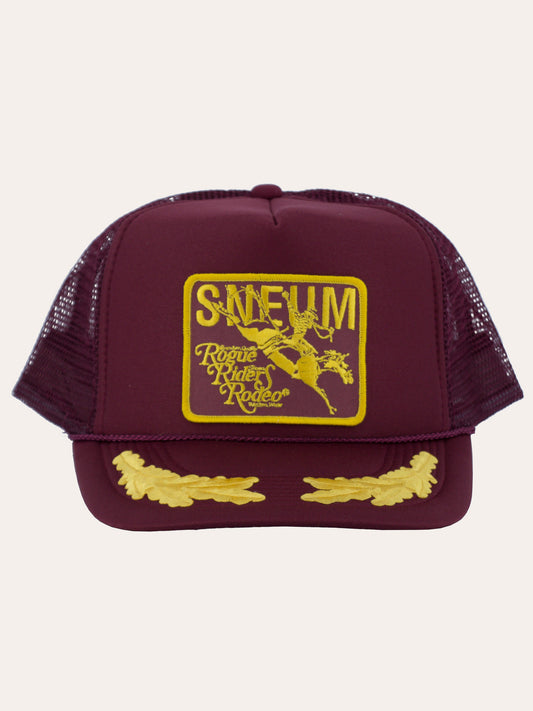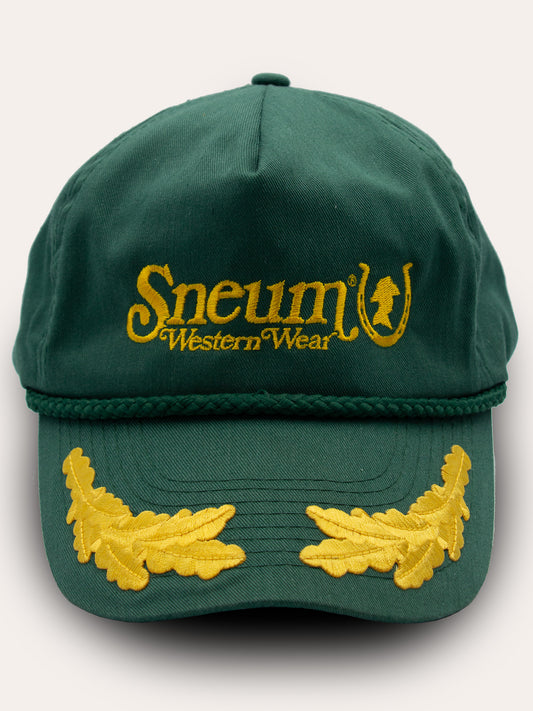The history of the trucker cap
The History and Cultural Significance of the Trucker Hat
The trucker hat, also known as the "gimme cap" or "feed cap," has become an iconic symbol of American culture, known for its utilitarian origins and subsequent adoption by various subcultures. Though today it is frequently associated with pop culture and fashion, its origins lie in the rural heartlands of the United States, where it served a purely functional role for workers in the farming and trucking industries.
Origins in the 1970s: A Practical Tool
The trucker hat, in its recognizable form, came about in the early 1970s as a promotional giveaway item distributed by U.S. feed, farming supply companies, and other agribusinesses. Initially designed as an affordable and functional accessory, the trucker hat was given to farmers, truck drivers, and rural laborers as part of promotional efforts. The companies offering these caps saw value in creating a useful item that could also serve as a walking billboard. The hats typically featured a wide foam front panel, which was ideal for emblazoning company logos or slogans, while the back was made of breathable mesh material, making it comfortable for long wear in the sun (Caldwell, 2013).
The defining features of the trucker hat included a stiff, structured front made from foam, paired with a long, stiff peak (or brim) for optimal sun protection. The use of lightweight and inexpensive materials, such as polyester mesh for the back, also helped make the hat both affordable and functional, as it allowed for ventilation and sweat absorption. These elements, combined with the hats’ durability, made them ideal for blue-collar workers who spent long hours outdoors (Walker, 2015).
Functional Evolution into Blue-Collar Uniform
The trucker hat quickly became a staple of rural workwear throughout the 1970s and 1980s. As a piece of gear provided primarily to truck drivers, farmers, and other laborers, it soon became part of the unofficial “uniform” of blue-collar America. Rural workers appreciated the cap’s ability to shield them from the sun while its breathable mesh back and sweat-absorbing foam front made it more comfortable than traditional all-fabric caps, especially in the hot summer months (Schneider, 2008).
This association with rural life, labor, and industry helped to cement the trucker hat’s place as a symbol of working-class culture. Over time, wearing one became a cultural marker of those involved in agriculture, transportation, and other labor-intensive jobs, particularly in the American Midwest and Southern states. As blue-collar labor became more strongly identified with the "backbone" of American industry, the trucker hat came to represent the wearers' hard work and no-nonsense attitude toward life and labor (O’Brien, 2007).
Rise in Popular Culture
Though originally a functional accessory for workers, the trucker hat made a significant crossover into mainstream American fashion in the early 2000s. Influenced by retro aesthetics and the rise of streetwear, celebrities and musicians—such as Ashton Kutcher and Pharrell Williams—began sporting trucker hats as part of their casual attire. This phenomenon was driven by the hat’s retro look and the broader trend of blending working-class fashion with urban street style (Lynskey, 2009).
The resurgence of trucker hats during this time was also linked to the broader "normcore" fashion movement, which embraced ordinary, everyday styles. What was once a symbol of rural and blue-collar identity was transformed into a countercultural statement, with high-fashion brands like Von Dutch adopting the trucker hat and rebranding it for a younger, fashion-conscious audience (Hogan, 2012).
The Trucker Hat Today: An Icon of Americana
By the mid-2000s, the trucker hat had completed its transformation from a functional piece of blue-collar workwear to a staple of Americana, celebrated both for its historical roots and its modern pop culture associations. Although its popularity in fashion has waxed and waned over the years, the trucker hat remains a beloved item that evokes a sense of nostalgia for rural America and the working class. It is also a symbol of American ingenuity, embodying the practical, no-frills approach to problem-solving that has long been associated with U.S. laborers (Hogan, 2012).
Today, trucker hats are worn by a wide demographic, transcending social and economic boundaries. While they continue to be produced as promotional items for companies, they are also sold by major fashion brands, demonstrating their continued appeal in American culture.
Conclusion
The trucker hat’s journey from a free promotional giveaway to a staple of American fashion underscores its cultural significance. Rooted in the American working class, it has evolved into a symbol of rural authenticity, resilience, and eventually, countercultural fashion. The trucker hat’s enduring presence in popular culture serves as a testament to the adaptability of fashion trends and the continued resonance of blue-collar symbolism in the American imagination.
References
- Caldwell, J. (2013). Trucker Hats and Americana: The Evolution of Rural Fashion. Journal of Popular Culture, 25(3), 45-62.
- Hogan, S. (2012). The Rise of Normcore: How Ordinary Became the New Cool. Fashion Studies Quarterly, 11(2), 22-38.
- Lynskey, D. (2009). From Workwear to Streetwear: The Trucker Hat and Its Influence on Modern Fashion. Urban Studies, 19(4), 110-126.
- O’Brien, T. (2007). Blue-Collar Chic: How American Workers Shaped Fashion. New York: HarperCollins.
- Schneider, J. (2008). The Cultural Meaning of the Trucker Hat in Rural America. Sociological Review, 32(2), 78-90.
- Walker, R. (2015). American Workwear: From the Fields to the Catwalk. New York: Random House.
Trucker caps
-
Sneum RRR logo trucker cap w. gold leaves
Regular price 70 EURRegular priceUnit price / per -
Trucker cap in cotton twill
Regular price 70 EURRegular priceUnit price / per

